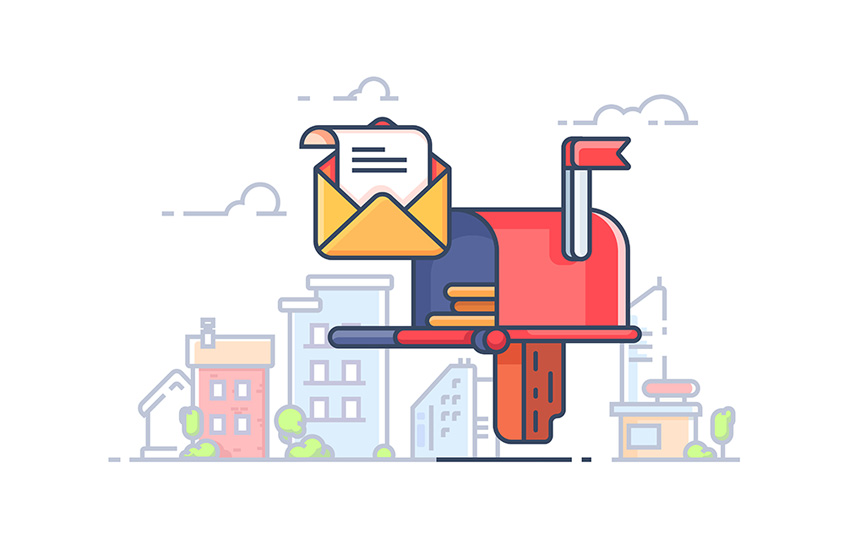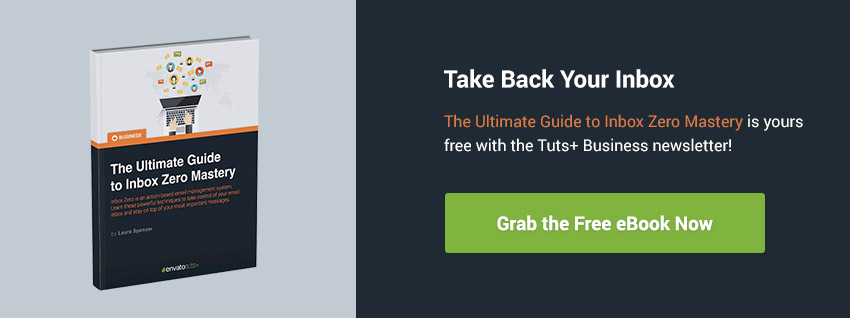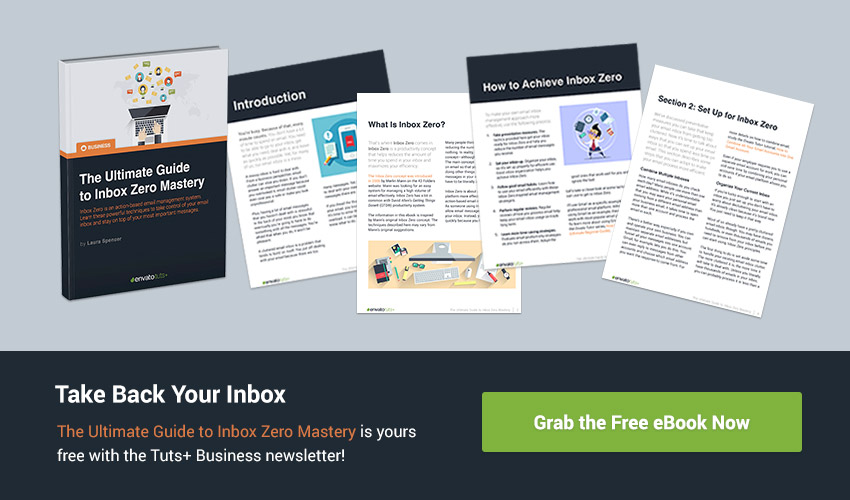Follow-up email can be one of the most challenging types of email to write. This is doubly true if you need to send a follow-up email after no response.

If you're hesitant to send an email follow-up, you're not alone. Many people are reluctant to send follow-up emails because they worry about bugging the recipient. Yet, a good follow-up email can mean the different between doing business with a client and not doing business.
In this tutorial, you'll learn how to write a follow-up email. We'll also answer some common questions that people have such as when to send a follow-up email and how long you should wait before sending it. We'll also provide a sample follow-up email.
When Is It Appropriate to Send an Email Follow Up?
Some messages are so important that you need to make sure they aren't missed. For those messages, it's a good idea to send a follow-up message.
Here are some situations that might require you to follow up on an email:
- Potential job. If you've sent out a resume or applied for a job, a follow-up email that further explains your qualifications may be what it takes to impress a recruiter and get noticed.
- Possible sale. A surprising reason many sales people fail is that they never follow up with a prospective client. They make the sales with prospects that are ready to buy right away, but miss out on future sales.
- Meeting request. If you've requested a meeting with someone and they haven't responded, follow up to find out whether they can attend or whether the meeting needs to be rescheduled.
- Communication with supervisor. Work-related emails are usually important. If some time has passed and your supervisor hasn't responded, follow up. They may have overlooked your email, or it might have been caught in their Spam filter.
- Project-related communication with peer. In most companies, you're part of a team. Your success (or failure) depends on your ability to communicate. If a team member isn't responding, you need to find out why.
I'm sure that you can think of many other situations where you should follow up after sending a message.
Email Follow Up Guidelines
If you hesitate to follow up on an unanswered email because you're worried about pestering the recipient, you're not alone. That same fear keeps many people from following up on their unanswered messages.
If the original email was important, though, it's probably still important. You should follow up on your important emails with no responses.
Note: If you've got a true emergency that must be addressed immediately, email is usually not the best way to contact someone. You'll have far more success making a phone call or seeing them in person (if they're located nearby).
Make Sure You Really Need to Follow Up
It's not unusual to miss a response to an email if your inbox is full of messages. Make sure that doesn't happen by keeping your inbox clutter-free.
To learn how to get a clutter-free email inbox and keep it, download a copy of our free eBook: The Ultimate Guide to Inbox Zero Mastery. You'll learn how to keep email "noise" out of your inbox so that you don't miss those important messages.

Also, don't forget to check your Spam and Trash folders. Sometimes important emails accidentally wind up in one of these two places.
If you're dealing with many contacts, this tutorial provides ways to find out whether an email was read:
How Long Should You Wait Before an Email Follow Up?
How long should you wait for response to an email before sending a follow-up email? Even experts don't always agree on the exact time frames. Plus, the time frame can vary depending on the situation, the company, the industry, and countless other factors.
However, here are some general guidelines for common types of emails:
- Thank you note (interview). A thank you note is a common type of follow-up email. It's most often used after a job interview. Usually, it's best to send a thank you note within 24 to 48 hours after the interview. You can follow up again in about a week.
- Resume or job application (no interview). If you've ever looked for a job, you know the drill. You send out resume after resume, application after application, and ... no response. It's acceptable to send a follow-up email after about a week.
- Meeting request. This one varies greatly depending on when the meeting is scheduled. Try to give the recipient enough time to work their meeting into their calendar, though. If the meeting is happening soon, a phone call may be the best follow-up approach.
- Work-related email (supervisor or peer). Most companies have guidelines about how quickly messages should be answered. Usually, the required response time is between 24 and 48 hours (excluding weekends). If your recipient has exceeded that time frame, it's okay to follow up. Keep in mind special circumstances, though, such as when a colleague is ill or out of the office.
- Touching base/networking. You've been to a meetup or other professional organization and you met someone in your field. You've added them to your contact list, but how do you stay in touch? Check back with them after a month and then about once every three months.
- Sales prospect. If you're in sales, it's especially important to follow up with your leads. You may have your leads categorized as hot, warm, and cold. Follow up more frequently with the hot leads, but don't neglect the others. The follow-up time frame varies, but in general follow the touching base guideline for warm prospects.
As I mentioned earlier, these are general guidelines. Your specific circumstances may be different. Of course, pay careful attention to and follow any specific instructions you're given.
For example, if you're being interviewed and the recruiter says, "I should know something tomorrow, give me a call." Then, that's what you do. You can usually send a thank you email as well, though.
How Often Should You Follow Up on an Email?
In some instances, such as when you're following up on a resume or job application, most human resources (HR) professionals agree: one follow-up email is usually enough. If you don't hear back from the company after that, they're probably not interested. Many HR professionals are flooded with applications and they may be annoyed if you contact them week after week about the same job.
If you're going to follow up with a lot of people, keep records. This is vital for sales people, but it can be important for others too. For example, if you're sending out lots of resumes it's easy to forget whether you've followed up with a company.
If you just have a few follow-up emails to track, a spreadsheet might be enough. Create a column for each of the following:
- Contact name
- Position
- Company name
- Contact email
- First follow-up date
- Next follow-up date
- Future follow-up date
- Notes (such as why they're on your contact list)
If you've got a very large list of contacts, say you're in sales, you may need a more powerful tool. Consider getting Customer Relationship Management (CRM) software. A good CRM tool not only keeps your contact records secure, it'll even prompt you to follow up with your leads regularly.
Important: If someone asks to be removed from your contacts list, respect their wishes. Don't follow up with them again.
Other Methods of Email Follow Up
If your follow-up efforts fail, remember that email isn't the only way to contact people. Some people are so busy they don't check their email very often. Or, they may have an assistant review their messages.
If your message is important, don't be afraid to follow up by phone. It's also becoming increasingly common to use text messaging for business communications.
How to Write an Effective Follow Up Email
You've determined you really do need to write a follow-up email. But for it to be effective, make sure it's professional. A good professional email should be:
- To the point
- Not too long
- Error-free
- Courteous
Also, make sure to include all the elements of a good business email. This tutorial explains proper business email format:
Don't forget that your subject line is important too. Avoid vague subject lines like:
Important Message
Or
Just Following Up
A better subject line includes more details:
Web Design Group Meeting, February 22, We Need Your RSVP
Or
Are You Going to the February Web Group Meeting?
The email that went with this subject line was sent to group members who didn't respond to an earlier email announcing the Web Design Group meeting. The message reminds the reader of the original meeting and asks for their RSVP.
Important: Don't send the reminder email to those group members who did respond to the meeting notice.
Don't forget that the opening and closing of your email is also important. Here's a tutorial that looks at email openings and closings in detail:
It's possible your email wasn't responded to because it didn't come across as being important. Read this tutorial to learn how to get your readers to respond:
If you need to write a thank you email after an interview, here's more guidance and a sample email to follow:
Next, let's look at a sample follow-up email.
Follow Up Email Sample
This sample of a follow-up email was sent to remind the members of a design group that they need to RSVP for the next group meeting.
The email looks like this:
Subject: Are You Going to the February Web Design Group Meeting?
Dear Member,
We haven't yet received your RSVP for our next Web Design Group dinner meeting and the deadline is drawing near. If you're coming, send your meal preference to: webdesigngroup@example.com. We must know who's coming before February 15th.
In case you missed our last email, this month's meeting will be held on February 22nd from 6:30 to 9:30 p.m. at the City Auditorium, 9876 Any Road, AnyTown.
Our topic this month is The Future of Web Design. Our speaker will be Jane Jones, CEO of Anytown Consulting.
I hope to see you there.
Sincerely,
Ashton Chang
President
Web Design Group
Notice the follow-up email is addressed to "Dear Member." Although it's usually more effective to address an email to an individual, this is a follow-up to a group email meeting notice. So, the phrase "Dear Member" can be used in this case.
Also, notice that the follow-up email is direct. It gets right to the point, then reviews the earlier email in case the recipient didn't get that one. Most importantly, it gives the reader a deadline to respond.
Finally, it closes with a professional signature. For even more tips on writing effective emails, look at this tutorial:
Grab the Free Email Inbox Mastery eBook
If you're needing helpful email strategies to put to work quickly, we have a special offer for you. Sign up for the Tuts+ Business Newsletter and get the Inbox Zero Mastery eBook for FREE. Discover how to apply the best email management techniques now.

Conclusion
You've just learned how to follow up on an unanswered email. You've also learned some helpful email follow-up principles. We've even provided a sample follow-up email to use as a guide when you write your own follow-up email.
You should now be ready to send your own follow-up emails. Good luck!
Editorial Note: This content was originally published on November 30, 2017. We're sharing it again because our editors have determined that this information is still accurate and relevant.






No comments:
Post a Comment